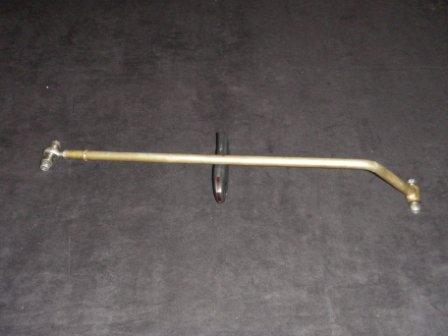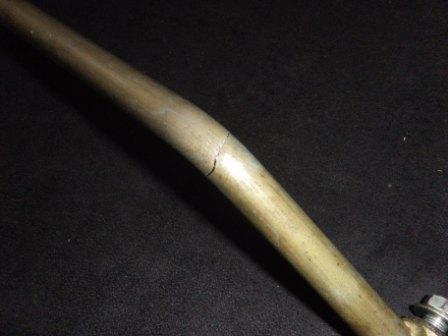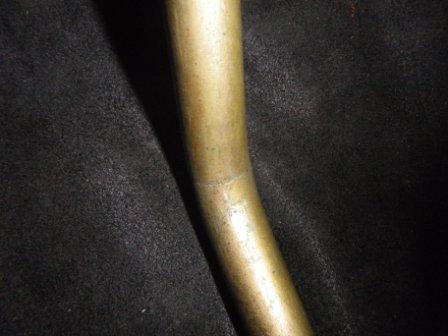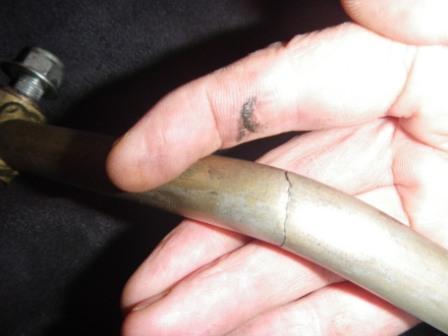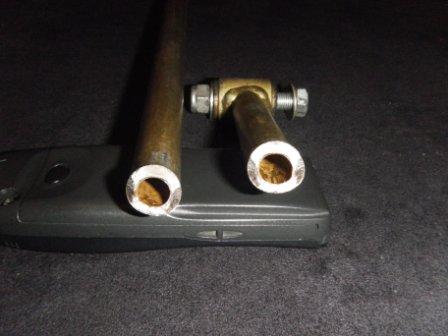NIK LINK FAILURE
Discussion
Any one ever had a Nik Link 'snap' for no apparent reason i.e. not incidental damage as part of an off / contact.
Rear one on our SR4 has sheared where it bends to go down; must have happened at Rockingham in the dry 1 November 2009 - only discovered when prepping the car first thing at Bedford yesterday before going on track. I'm no metallurgist, but it looks like metal fatigue to me - clean break, metal looks kind of crystalline.
Think I should refer it to Radical? Just thinking the speed you racers carry round corners - to say the least, a bit of a brown pants moment if one suddenly let go going into / halfway round a bend?
Rear one on our SR4 has sheared where it bends to go down; must have happened at Rockingham in the dry 1 November 2009 - only discovered when prepping the car first thing at Bedford yesterday before going on track. I'm no metallurgist, but it looks like metal fatigue to me - clean break, metal looks kind of crystalline.
Think I should refer it to Radical? Just thinking the speed you racers carry round corners - to say the least, a bit of a brown pants moment if one suddenly let go going into / halfway round a bend?
From my distant past don't fatigue failures show as two distinct areas in the breakage rather than one clean break - one area where the joint has failed from then bending (or whatever load) and then the crystal like part you mention where the remaining metal was insufficient to support the load - like the image here: http://www.uh.edu/engines/epi2260.htm
Edited by nick997 on Wednesday 11th November 12:02
are the nik links on the SR4 the same as the prosport ??
i didn;t think they were a great design since you had to 'tweak' the bar's to fit to ensure there was no pre load in the bar when installed... the 'tweak' to get it to fit could well have been enough over time to weaken it at that point ??
i didn;t think they were a great design since you had to 'tweak' the bar's to fit to ensure there was no pre load in the bar when installed... the 'tweak' to get it to fit could well have been enough over time to weaken it at that point ??
Nick: Can't access that link; it's showing "error, file not found".
Mark: Can't be sure, but think so; look to be the same, same pic, same price. Don't really get what you mean. Straight end detached front and rear and cable tied to run in extremely wet at Rockingham, then re-attached when it dried and we went back onto slicks. Simply lined back up and put bolt and bushes back in, no tweaking involved. Can you amplify?
Little bit poorly at the mo; as soon as feeling better will try to take some photos and post on here ........ I don't like important bits that just fail dramatically, not under any degree of hammer and for no apparent reason. One thinks "what's next and when?" Let's not forget that this is a car that's never been raced nor ever had a memorable off - e.g. rather exceptionally, all the body panels are the ones that it actually left the factory with.
Mark: Can't be sure, but think so; look to be the same, same pic, same price. Don't really get what you mean. Straight end detached front and rear and cable tied to run in extremely wet at Rockingham, then re-attached when it dried and we went back onto slicks. Simply lined back up and put bolt and bushes back in, no tweaking involved. Can you amplify?
Little bit poorly at the mo; as soon as feeling better will try to take some photos and post on here ........ I don't like important bits that just fail dramatically, not under any degree of hammer and for no apparent reason. One thinks "what's next and when?" Let's not forget that this is a car that's never been raced nor ever had a memorable off - e.g. rather exceptionally, all the body panels are the ones that it actually left the factory with.
depending on set up, ride heights, corner weight adjustments etc etc... the bars don't fit straight back in - and you have to 'tweak' the bar to fit again to make sure there is no tention on the bar while at ride height/driver on board etc..
Theoretically if you never made any set up changes, ride height adjustments etc etc and driver/car weight was identical they would always fit as is.. but i'd say very unlikely to not need a slight 'tweak'
Theoretically if you never made any set up changes, ride height adjustments etc etc and driver/car weight was identical they would always fit as is.. but i'd say very unlikely to not need a slight 'tweak'
Here's a close-up of the fracture faces.
Incidentally, in asking whether anyone has come across this before, not for a minute am I pointing any sort of finger in Radical's direction. Guys like me who have so far used their Radicals for trackdays (carrying way less pace than you racer chaps and deliberately not running kerbs in the way that race conditions involve/require) are always trying to second guess what factor to apply to Radical's lifing chart. I have a very complete history on this car and from what I can see, the Nik Links are the same ones that it rolled out of the factory with in 2004. This being the case, they have done lots and lots of hours working away. This may well eventually prove to be a heads-up for the benefit of each and every Radical Owner .......... your oil pressure gauge / run time loggers might give you the obvious heads-up about getting the motor back over to Powertec for a refresh, but don't forget about the other bits where there's no gauge to watch/not everyone is a metallurgist with microscopes and x-ray crack testers to hand. Maybe we finish up with lifing amplification, like every 30 hours / annually whichever is sooner inspect and replace if necessary, 90 hours / every two years whichever is sooner replace irrespective. Who knows. If it only serves to make everyone ask/think how many hours have my wishbones / uprights / nik links done? and that makes things safer by avoiding failures in a much closer proximity and more intensive environment than I presently use my Radical, good, even if it does mean laying out some cash to the good folks at Peterborough.
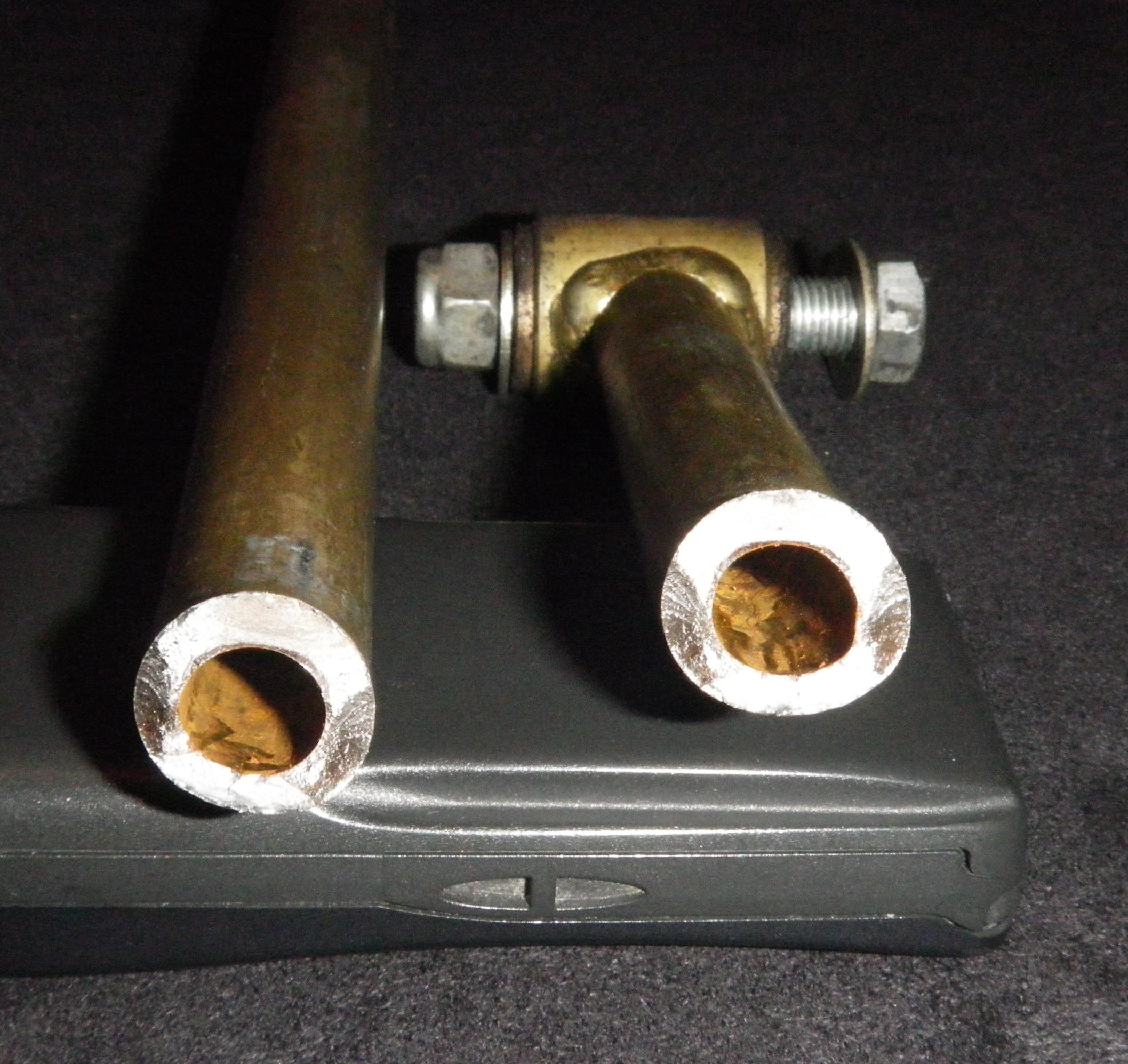
Incidentally, in asking whether anyone has come across this before, not for a minute am I pointing any sort of finger in Radical's direction. Guys like me who have so far used their Radicals for trackdays (carrying way less pace than you racer chaps and deliberately not running kerbs in the way that race conditions involve/require) are always trying to second guess what factor to apply to Radical's lifing chart. I have a very complete history on this car and from what I can see, the Nik Links are the same ones that it rolled out of the factory with in 2004. This being the case, they have done lots and lots of hours working away. This may well eventually prove to be a heads-up for the benefit of each and every Radical Owner .......... your oil pressure gauge / run time loggers might give you the obvious heads-up about getting the motor back over to Powertec for a refresh, but don't forget about the other bits where there's no gauge to watch/not everyone is a metallurgist with microscopes and x-ray crack testers to hand. Maybe we finish up with lifing amplification, like every 30 hours / annually whichever is sooner inspect and replace if necessary, 90 hours / every two years whichever is sooner replace irrespective. Who knows. If it only serves to make everyone ask/think how many hours have my wishbones / uprights / nik links done? and that makes things safer by avoiding failures in a much closer proximity and more intensive environment than I presently use my Radical, good, even if it does mean laying out some cash to the good folks at Peterborough.

As Nick997 says, this is a classic ‘nearly gone – really gone’ failure. The shiny silvery white area shows a gradual failure while the much rougher area tells of the, final, catastrophic, failure.
The cause seems to be associated with the bend in the Niklink and it would be interesting to understand the grade of steel from which the Niklink is originally made; the process by which it was bent to shape, whether the material thickness was significantly changed when the component was bent; and any tempering/peening process that might have followed.
Also of interest is the corrosion that appears to be present within the bar, as corrosion is obviously an especially bad thing when you can’t see it and - if the original stress failure was on the inside – the corrosion would have invaded the origin and made the situation still worse.
For clarity, I’m in no sense being critical of Radical and - on the basis that this is (I presume) a new problem - it is reasonable to presume that proper maintenance; inspection (x-ray, if you want to do it properly); and lifeing of this component might have saved the day. If you're warranty minded, run this past Radical first, but a CAREFULLY PLACED & STRESS RELIEVED hole in such a part that is just big enough to accept a regular squirt of WD40 is a really good idea. Please note 'carefully placed' and 'stress relieved'.
Anyway, assuming the part has been correctly specified to begin with, it’s also possible to presume that - in a necessarily ‘production line’ environment - an occasional ‘pup’ must also slip through the net.
In any case, at the end of the day - whatever you’re doing with your Radical - you’ve actually bought a racing car (of sorts) which needs special care and inspection.
The cause seems to be associated with the bend in the Niklink and it would be interesting to understand the grade of steel from which the Niklink is originally made; the process by which it was bent to shape, whether the material thickness was significantly changed when the component was bent; and any tempering/peening process that might have followed.
Also of interest is the corrosion that appears to be present within the bar, as corrosion is obviously an especially bad thing when you can’t see it and - if the original stress failure was on the inside – the corrosion would have invaded the origin and made the situation still worse.
For clarity, I’m in no sense being critical of Radical and - on the basis that this is (I presume) a new problem - it is reasonable to presume that proper maintenance; inspection (x-ray, if you want to do it properly); and lifeing of this component might have saved the day. If you're warranty minded, run this past Radical first, but a CAREFULLY PLACED & STRESS RELIEVED hole in such a part that is just big enough to accept a regular squirt of WD40 is a really good idea. Please note 'carefully placed' and 'stress relieved'.
Anyway, assuming the part has been correctly specified to begin with, it’s also possible to presume that - in a necessarily ‘production line’ environment - an occasional ‘pup’ must also slip through the net.
In any case, at the end of the day - whatever you’re doing with your Radical - you’ve actually bought a racing car (of sorts) which needs special care and inspection.
Count Johnny said:
As Nick997 says, this is a classic ‘nearly gone – really gone’ failure. The shiny silvery white area shows a gradual failure while the much rougher area tells of the, final, catastrophic, failure.
The cause seems to be associated with the bend in the Niklink and it would be interesting to understand the grade of steel from which the Niklink is originally made; the process by which it was bent to shape, whether the material thickness was significantly changed when the component was bent; and any tempering/peening process that might have followed.
Also of interest is the corrosion that appears to be present within the bar, as corrosion is obviously an especially bad thing when you can’t see it and - if the original stress failure was on the inside – the corrosion would have invaded the origin and made the situation still worse.
For clarity, I’m in no sense being critical of Radical and - on the basis that this is (I presume) a new problem - it is reasonable to presume that proper maintenance; inspection (x-ray, if you want to do it properly); and lifeing of this component might have saved the day. If you're warranty minded, run this past Radical first, but a CAREFULLY PLACED & STRESS RELIEVED hole in such a part that is just big enough to accept a regular squirt of WD40 is a really good idea. Please note 'carefully placed' and 'stress relieved'.
Anyway, assuming the part has been correctly specified to begin with, it’s also possible to presume that - in a necessarily ‘production line’ environment - an occasional ‘pup’ must also slip through the net.
In any case, at the end of the day - whatever you’re doing with your Radical - you’ve actually bought a racing car (of sorts) which needs special care and inspection.
Thanks for your assessment as to the cause of the failure Jonny. The suggested diagnosis that this was a gradual failure as opposed to a forced or abrupt one fits in with the lack of a single moment of impact force occuring. I suspect that this is a case of too many hours use or 'user error'! It's not suprising to me that if a fracture has to happen, it is very much likely to occur at the bend point particularly as in most likely this case it is down to over use.The cause seems to be associated with the bend in the Niklink and it would be interesting to understand the grade of steel from which the Niklink is originally made; the process by which it was bent to shape, whether the material thickness was significantly changed when the component was bent; and any tempering/peening process that might have followed.
Also of interest is the corrosion that appears to be present within the bar, as corrosion is obviously an especially bad thing when you can’t see it and - if the original stress failure was on the inside – the corrosion would have invaded the origin and made the situation still worse.
For clarity, I’m in no sense being critical of Radical and - on the basis that this is (I presume) a new problem - it is reasonable to presume that proper maintenance; inspection (x-ray, if you want to do it properly); and lifeing of this component might have saved the day. If you're warranty minded, run this past Radical first, but a CAREFULLY PLACED & STRESS RELIEVED hole in such a part that is just big enough to accept a regular squirt of WD40 is a really good idea. Please note 'carefully placed' and 'stress relieved'.
Anyway, assuming the part has been correctly specified to begin with, it’s also possible to presume that - in a necessarily ‘production line’ environment - an occasional ‘pup’ must also slip through the net.
In any case, at the end of the day - whatever you’re doing with your Radical - you’ve actually bought a racing car (of sorts) which needs special care and inspection.
Again sound advice that any race car requires special attention where stresses and strains are regularly applied to many of the parts. I have never heard of this failure occuring on a Radical as used on trackdays. Raced cars obviously experience a higher level of stress on components and these parts are as a matter of course replaced at the advised periods/hours of usuage, hence why this fracture is most likely be an isolated case.
jpivey said:
Not good I think you will find that the bars are made from what ever steel and not spring steel, I would send a mail to radical and see what they say.
Mark you don't have to tweak the bars on a SR4 as they have a rose joint so you can alter them.
ah... understood JP.Mark you don't have to tweak the bars on a SR4 as they have a rose joint so you can alter them.
It should be noted to club/prosport guys out there that they may want to 'life' these parts then - given the 'tweak' required to keep them in place without tention..
Like JP says - they are made from xyz steel, whereas most conventional antiroll bars are made of spring steel..
Having said that guys - it broke, and you didn't notice, nor did it fire you off the track.. so at least not an absolute critical component like a wishbone or upright failure for example...
Be interested in Radicals response nonetheless
Good discussion, but it's pretty simple: it's a basic component that undertakes a basic function, probably inexpensively made (material and production), simple failure at it's natural weakpoint caused by it's inherent design or external factor or a bit of both. I can elaborate as required.
None of that is necesserily bad or poor practice in the context of what the component is/does/costs; equally not massively difficult to life it either with a quick calc/assumptions.
None of that is necesserily bad or poor practice in the context of what the component is/does/costs; equally not massively difficult to life it either with a quick calc/assumptions.
mabbott said:
I can elaborate as required.
equally not massively difficult to life it either with a quick calc/assumptions.
Would appreciate if you could Mark.equally not massively difficult to life it either with a quick calc/assumptions.
Likewise, how you would life it.
And let's not forget what I said in the first instance - me simply being rather surprised by this occurence and asking guys who have many many more years experience of running Radicals than I have (and using them way harder than I do) whether they had ever come across/had experience of it before. Yourself?
By the way, despite what the photos appear to show, there is no real corrosion inside as one would envisage from the use of that word; just the absolutely surface brightish orange discolouration that any ferrous component will show from being exposed to air for a few days.
Also, what is meant by this Clubsport 'tweaking'? Hitting it with a hammer to bend it or flatten it a bit more? If so, that doesn't sound a brilliant idea.
Edited by splitpin on Thursday 12th November 14:24
I wouldn't bother going to Radical on this one gents, you'll either get one of two answers:
"ohhh, i've never seen that before"
or the simple
"yeah that happens!"
I've seen this before on an SR4, and whilst initially shocking at the time, it didn't seem to make much difference to the driver. It's a simple fatigue failure, that is more than likely to happen sooner or later on the bend of a hollow stressed tube.
I'd suggest if you are driving the cars hard, and they are beginning to age, that you might want to start carrying these in your spares packages.
"ohhh, i've never seen that before"
or the simple
"yeah that happens!"
I've seen this before on an SR4, and whilst initially shocking at the time, it didn't seem to make much difference to the driver. It's a simple fatigue failure, that is more than likely to happen sooner or later on the bend of a hollow stressed tube.
I'd suggest if you are driving the cars hard, and they are beginning to age, that you might want to start carrying these in your spares packages.
Sorry for late the reply, been busy. I think the above posts cover things nicely...
The part has failed at its inherent weak point as designed. The cause of the failure is either down to poor design (i.e. due consideration of the component geometry with respect to the loading and/or inadequate specification of materials), or a secondary factor (manufacturing variation, extreme loading, corrosion etc etc etc) that has lead to an erosion of the component’s original fatigue limit intended by design (assuming it was even considered). My guess is a bit of both.
Translating my garb: a failure is fairly inevitable. Whether or not you view this as good or bad has to be taken in context of what the part is/does.
Let’s be fair it’s a simple part cheaply made and subject to some basic (cyclic/axial) loads that are a function of the car’s lateral grip and vertical suspension movement. It’s here we get into the ‘fun’ of how you design (at sensible total costs) for this; what is a ‘normal’ operation for a racing car? You could go around on that forever...
On the question of usage; yes, a track car might see less relative ‘abuse’, but I suspect there are so many variables in how people run/treat their cars across such a small volume of parts (of equally variable construction) that a statistical comparison of what others have experienced is not going to yield much information. You might get the odd similarity, but a trend is unlikely.
On the lifing topic, calculating stress ranges as a function of lateral grip and/or suspension movement is straightforward, as is establishing fatigue limit from an S-N diagram, but in the real world the likelihood of the part working outside the assumptions you will need to make to get to the calculation ultimately make for a pretty meaningless figure.
Which returns us nicely to the context of what the part is/does.
My view - you get what you pay for... I should be bored on a train more often!
The part has failed at its inherent weak point as designed. The cause of the failure is either down to poor design (i.e. due consideration of the component geometry with respect to the loading and/or inadequate specification of materials), or a secondary factor (manufacturing variation, extreme loading, corrosion etc etc etc) that has lead to an erosion of the component’s original fatigue limit intended by design (assuming it was even considered). My guess is a bit of both.
Translating my garb: a failure is fairly inevitable. Whether or not you view this as good or bad has to be taken in context of what the part is/does.
Let’s be fair it’s a simple part cheaply made and subject to some basic (cyclic/axial) loads that are a function of the car’s lateral grip and vertical suspension movement. It’s here we get into the ‘fun’ of how you design (at sensible total costs) for this; what is a ‘normal’ operation for a racing car? You could go around on that forever...
On the question of usage; yes, a track car might see less relative ‘abuse’, but I suspect there are so many variables in how people run/treat their cars across such a small volume of parts (of equally variable construction) that a statistical comparison of what others have experienced is not going to yield much information. You might get the odd similarity, but a trend is unlikely.
On the lifing topic, calculating stress ranges as a function of lateral grip and/or suspension movement is straightforward, as is establishing fatigue limit from an S-N diagram, but in the real world the likelihood of the part working outside the assumptions you will need to make to get to the calculation ultimately make for a pretty meaningless figure.
Which returns us nicely to the context of what the part is/does.
My view - you get what you pay for... I should be bored on a train more often!
Cheers Mark
Trains, oh such joy!
I've concluded that a part that is not very expensive did darn well. Five year old car, two years of which were active and not within our ownership. Many trackdays overall; those within our ownership and those prior, the latter including some in dramatically quick and talented hands like The Verge, some equally in first time ever hands.
So many miles of constantly doing it's job, way more than a race car would probably ever do, albeit less kerb short-cutting, certainly when we've been driving it on our trackdays.
Our rule of thumb for non-abusive trackdaying only is now to carefully check them regularly, completely remove and blue 'em every season end and replace every two/three years irrespective.
Much appreciate your input.
Trains, oh such joy!
I've concluded that a part that is not very expensive did darn well. Five year old car, two years of which were active and not within our ownership. Many trackdays overall; those within our ownership and those prior, the latter including some in dramatically quick and talented hands like The Verge, some equally in first time ever hands.
So many miles of constantly doing it's job, way more than a race car would probably ever do, albeit less kerb short-cutting, certainly when we've been driving it on our trackdays.
Our rule of thumb for non-abusive trackdaying only is now to carefully check them regularly, completely remove and blue 'em every season end and replace every two/three years irrespective.
Much appreciate your input.
Edited by splitpin on Tuesday 24th November 23:39
Gassing Station | Radical | Top of Page | What's New | My Stuff




